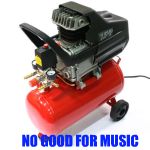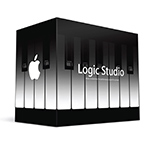This blog is an archive. Nowadays you’ll find me at blowintpieces.com and on Twitter.
Compressors – The theory
Published December 25, 2007 Audio Gear , Computer Stuff 7 CommentsTags: audio, compressors, how to, limiter
 No matter what music you compose, you’ll eventually have to deal with compressors. There is just no escaping. Compressors are what you apply to make music better. That’s right. They help you make your music beyond studio quality. You’re one plug-in away from stardom!
No matter what music you compose, you’ll eventually have to deal with compressors. There is just no escaping. Compressors are what you apply to make music better. That’s right. They help you make your music beyond studio quality. You’re one plug-in away from stardom!
All the glamour aside, compressors are one of the studio workhorses that are applied to achieve anything from subtle smoothing to downright squashing. It does help to know how the tools you use work though, and I’m hopefully going to provide you with just that. Let’s go from knob fiddling to consistent predictable results! Follow the link for an easy FREE introductory promotional kit (order the full 3 x video tape kit NOW and receive an instant $3.00 rebate!)
 Machines are designed to help us. While they mostly cause nothing but headaches, they can come in handy when you program them right. The continuing story of the Beatles bootlegs has prompted me to start learning AppleScript to automate a number of tasks I typically perform on tags within iTunes, but then I realized that my problems are probably far from unique. Indeed, there are other nerds out there who have already written a number of useful scripts of us to use. Unfortunately, it takes being a geek to find geeky things, so here is a nice pretty Best Of compilation of useful iTunes scripts for all you people who don’t feel like dipping into the nerd scene.
Machines are designed to help us. While they mostly cause nothing but headaches, they can come in handy when you program them right. The continuing story of the Beatles bootlegs has prompted me to start learning AppleScript to automate a number of tasks I typically perform on tags within iTunes, but then I realized that my problems are probably far from unique. Indeed, there are other nerds out there who have already written a number of useful scripts of us to use. Unfortunately, it takes being a geek to find geeky things, so here is a nice pretty Best Of compilation of useful iTunes scripts for all you people who don’t feel like dipping into the nerd scene.

UPDATE: I have created Fluke which makes playing FLACs through iTunes on a Mac much easier. Neither Fluke nor the instructions will work for Windows users though, sorry. Winamp?
Some time ago I had acquired a collection of certain Beatles recordings in FLAC format (65 pounds of Beatles vinyls on my shelf keep me guilt-free), and since the only lossless format iPods would play was Apple Lossless, converting to that format was my only option. Now, while I support the great idea of open lossless that is FLAC, Apple has really been a bitch about implementing it into iTunes. There have been rumours support for it will be present when Leopard comes along, but I think we’ll more likely see native support for WMA files than FLAC.Before today, the method I used to use was: I would take the album in FLAC, put it through xACT which would convert it to .AIFF, effectively doubling the number of song files on my hard drive and getting rid of all the tags entirely; then importing those .aiff files into iTunes, tagging them by hand a little bit, converting the result to Apple Lossless, getting rid of the intermediate .aiff files, and then putting everything through iEatBrainz, the automatic tagging software which bases its algorithm on a checksum of the audiofile, and not the length of all tracks like iTunes does. Now, on their website, the creators of iEatBrainz failed to mention that it doesn’t fucking work most of the time, so I would end up tagging almost everything by hand.Today, I got seriously pissed off at not being able to instantly listen to A Hard Day’s Night, and instead of ripping the LP like I wanted to, I found a workaround for this. Here is what you do.
 Great news everyone – D’Naab 136, the guy who designed the replacement for the Juno 106 chips, has just let me know he released a version two of his creation, which is smaller, better, and helps to keep your dog happy. Or your snake. And it’s still 40 euros. Awesome!
Great news everyone – D’Naab 136, the guy who designed the replacement for the Juno 106 chips, has just let me know he released a version two of his creation, which is smaller, better, and helps to keep your dog happy. Or your snake. And it’s still 40 euros. Awesome!
I bought a bunch of original chips off eBay last year, and one of them already died, plus there is one more that’s getting really noisy. Learn from my stupidity, and get the replacement chips.
Now, I’ve received quite a few comments to my original post with people asking how to fix their Juno. Most of those had to do with the same old VCF/VCA chips dying. I have put together a list of possible symptoms of a dead chip.
 I know I said I’d like to keep the blog free of discussions of software or hardware. But then, I also wanted the blog to enrich Internet with original content valueable to newcomers and professionals alike, or something like that, so that’s my excuse.
I know I said I’d like to keep the blog free of discussions of software or hardware. But then, I also wanted the blog to enrich Internet with original content valueable to newcomers and professionals alike, or something like that, so that’s my excuse.
Besides, people constantly ask the versus questions, which fuels all sorts of flame throwing. I’m using both DAWs equally often now, so I’ll try to give you an idea why/when you’d use one over the other without all the “Logic just sounds better” crap.
UPDATE: Now that I’ve used Logic for quite some time, I have a bit of an update.
PowerBook + Ultralite: Unable to Launch MIDI server
Published February 7, 2007 Audio Gear , Computer Stuff 23 CommentsWe had a guy drop in the store with a machine today. He just couldn’t get the MIDI to work at all, and the problem appeared to happen on the OS and not the software level.
We would go into the Audio MIDI Setup utility, and after spinning the beach ball for a little while, the MIDI tab would tell us that it was “Unable to Launch MIDI server”. Turns out, Digidesign was to blame. I think they are quickly turning into the audio world scape goat ala Microsoft, and for a good reason too.
UPDATE: One of the people who commented on this post, franck, may have come up with a solution, or at least a temporary fix. I don’t have an Ultralite on hand so let me know if it works out for you. And make sure to comment if it doesn’t – maybe we can at least make MOTU listen and absorb the costs of getting this worked out. Seriously, what the fuck.
Continue reading ‘PowerBook + Ultralite: Unable to Launch MIDI server’
 Since May, MacBook has been one of Apple’s best-selling computers. Up until the Core 2 Duo upgrade of MacBook Pro’s, it matched its ‘pro’ bro in specs quite closely, with up to a 2.0 Ghz Core Duo CPU and 2 GB of RAM.
Since May, MacBook has been one of Apple’s best-selling computers. Up until the Core 2 Duo upgrade of MacBook Pro’s, it matched its ‘pro’ bro in specs quite closely, with up to a 2.0 Ghz Core Duo CPU and 2 GB of RAM.
As many others, I saw the MacBook as a smarter option for the work I do, plus it would be far more powerful than my then current tower. I do quite a bit of audio and MIDI recording with Cubase outside of my full-time job here at a Mac reseller store, and got one of the 2.0 Ghz white Core Duo MacBooks as my main computer.
I found it quite suitable for audio work, except for a few quirks, which, depending on the audio work you do, will either not bother you, or drive you nuts.
 From what I see working at an Apple Reseller store here in Vancouver, MacBooks are currently the hottest selling computers by Apple. Despite the infamous random shutdown, despite the occasional overheating, and yellowing of the case, the sales are quite high.
From what I see working at an Apple Reseller store here in Vancouver, MacBooks are currently the hottest selling computers by Apple. Despite the infamous random shutdown, despite the occasional overheating, and yellowing of the case, the sales are quite high.
Now, a lot of people don’t understand why you have to always have two identical RAM sticks in the MacBook. Especially those whiny PC users – they always want to buy one 1gb stick of RAM, and keep the other slot empty in case they want to upgrade later (pff). Well, I am a MacBook owner myself now, so I decided to find out what really happens if you just use one stick of RAM. (Spoiler: There are lots of explosions, naked girls, and Bill Gates jokes involved, so read on).
 I’ve finally got around fixing my Juno. She really did deserve it, as it turned out. I’m going to, in an accessable manner and without snobby comments (I’ve tried my best), explain the common voice chip problem of the Juno, how to recognize and fix it, as well as learn to do it all without burning the house down.
I’ve finally got around fixing my Juno. She really did deserve it, as it turned out. I’m going to, in an accessable manner and without snobby comments (I’ve tried my best), explain the common voice chip problem of the Juno, how to recognize and fix it, as well as learn to do it all without burning the house down.
UPDATE: For a short list of symptoms, check out the update post.